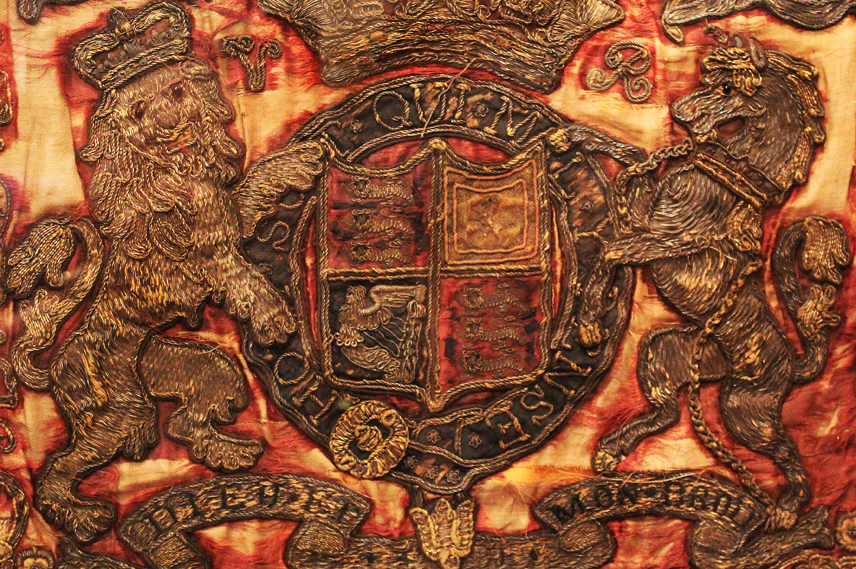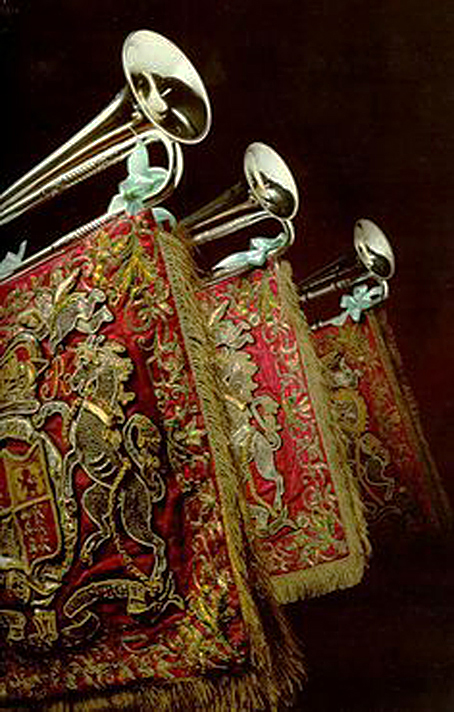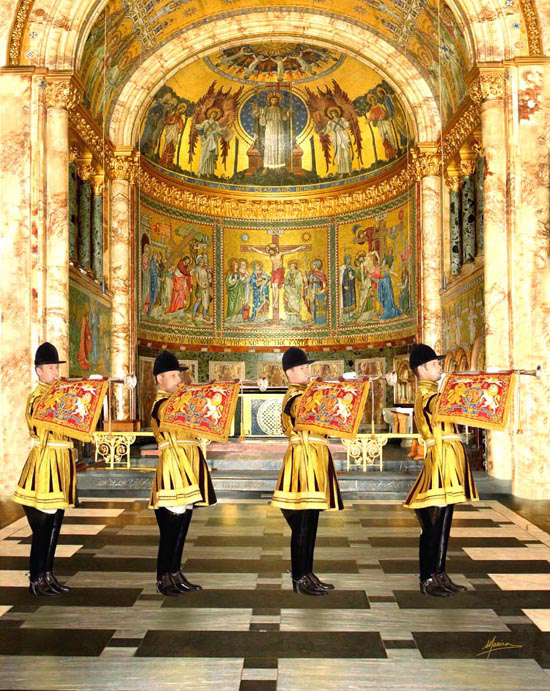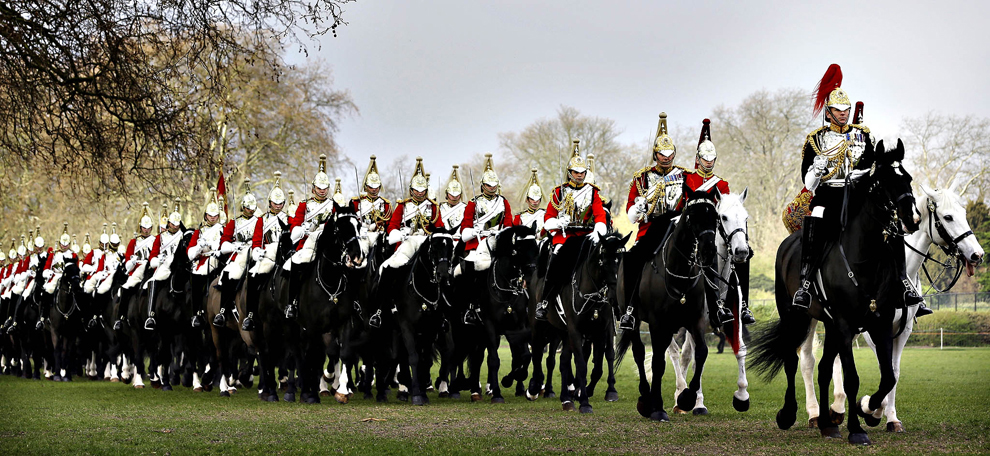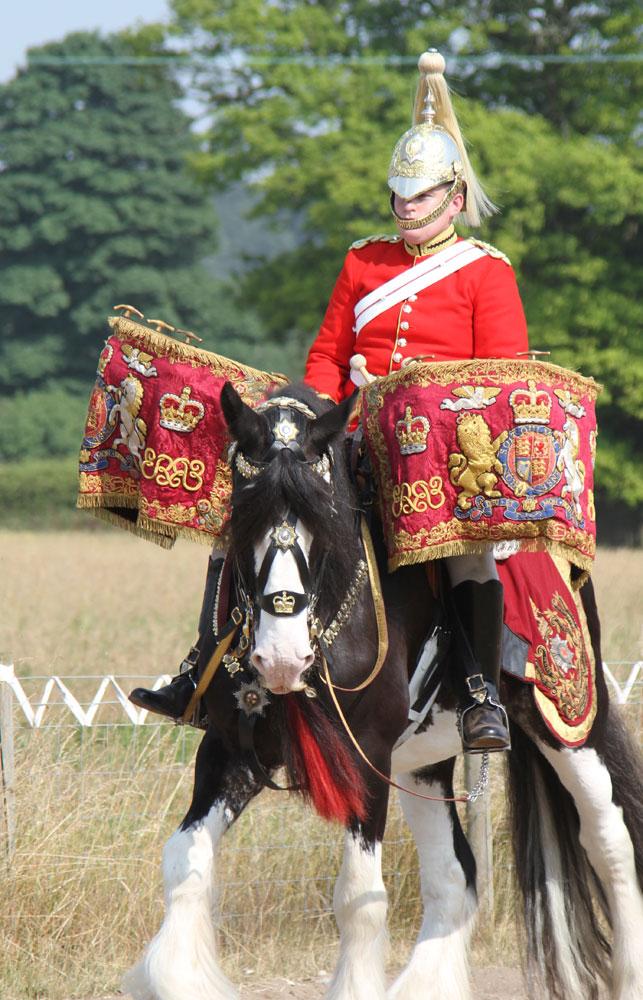A Most Resplendent, Original Antique and Rare, Victorian, Royal Household, Royal Horse Guards Fanfare Trumpet Banner
Rarely seen or available these wondrous pieces of magnificent, British, Royal Household regalia were never made for use other than for royal service within the bodyguard of the reigning British monarch, they are used on horseback or standing on trumpets and in pairs when they fit on the front of both kettle drums . They were and are always made of the finest quality materials, such as silk, purest gold and silver, by craftsmen and women with superlative skill and dedication. When taken from service these wonderful pieces were more often than not hung in churches or cathedrals to commemorate men or officers of the Household Cavalry lost in battle. This banner is composed of crimson silk damask, embroidered with the 1837 Royal Arms of Her Majesty Queen Victoria, in silks, gold and silver bullion wire. Edged with a gold thread fringe. It is now in faded and worn condition as to be expected for a piece of such age and use. The present royal service trumpet banner conforms to the design type first introduced in the reign of Charles II (1660-1685).
The history of the Band of The Life Guards began when King Charles II entered London accompanied by a throng of 20,000 horse and foot on his birthday, 29th May 1660. On this day, commemorated as Oakapple Day in recognition of his escape when a fugitive by hiding in the Boscobel Oak Tree, it is recorded that, at the public entry into London, he was escorted by three troops of The Life Guards each preceded by it's own kettledrummer and four trumpeters. The origins of the Band you hear today derive from this proud occasion. At this time the use of kettledrums and trumpets was confined to the Army and the nobility and, even among the Kings troops. The Life Guards alone had the privilege of using kettledrums. The musicians held warrants of appointment from the King were paid at the rate of five shillings per day. In 1678 they wore uniforms of velvet, silver laced, and their instruments had richly embroidered and trimmed banners, the whole cost defrayed by the King. This is the origin of the State Dress worn to this day by the Band and Trumpeters. The design was based on that of the King?s racing colours and, when Parliament refused to cover the full cost of the Gold Coats, the Lord Mayor of London met the outstanding debt. In recognition of this he is the only person outside the Royal Family for whom Gold Coats are worn.
The Royal Horse Guards were formed in 1661 from cavalry of the former New Model Army and were given the nickname of the Oxford Blues, in recognition of their first colonel, the Earl of Oxford, and to their blue uniforms. It is recorded that from the outset that the Regiment had kettledrummers and trumpeters. In 1661 the Tangier Horse was raised for service on the Mediterranean coast of Africa. By 1702 the Tangier had changed to a Dragon Regiment and evolved to be The Royal Dragoons (1st Dragoons) and had a band consisting of 8 drummers and 8 hautbois (an early form of oboe). Soon after, in 1710, kettledrummers were added and in 1766 the drummers were converted to trumpeters. The Royal Horse Guards (The Blues) had also acquired trumpeters and drummers and in 1805 King George III personally presented a pair of solid silver kettledrums as testimony to their Honourable and Military conduct on all occasions. These kettledrums continue to be used today and can be seen carried and played by the mounted drummer on the Queen's Birthday Parade on Horse Guards. In 1969 The Royal Horse Guards (The Blues) amalgamated with 1st The Royal Dragoons (The Royals) to become The Blues and Royals (Royal Horse Guards and 1st Dragoons). This banner would have been used in the eras of; First Opium War 1839-1842
First Anglo Marri War 1840
First Anglo-Sikh War 1845-1846
Second Anglo-Burmese War 1852-1853
Crimean War 1853-1856
Anglo-Persian War 1856-1857
Second Opium War 1856-1860
Indian Rebellion 1857
New Zealand land wars 1845-1872
Second Anglo-Sikh War 1848-1849
Second Ashanti War 1863-1864
Bhutan War 1864-1865
Third Ashanti War 1873-1874
Second Anglo-Afghan War 1878?1880
Anglo-Zulu War 1879
Second Anglo Marri War 1880
First Boer War 1880-1881
Third Anglo-Burmese War 1885
Mahdist War 1891-1899
Fourth Ashanti War 1894
Anglo-Zanzibar War 1896 Shortest war in history lasted 38 minutes
Boxer Rebellion 1899-1901
Second Boer War 1899-1902
Framed and glazed in a simple modern gilt frame. It could be so much complimented by a fine antique Georgian or Victorian frame
Code: 22531
2950.00 GBP


